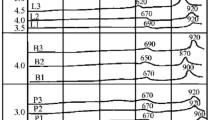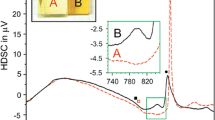Abstract
Glasses are synthesized in the SnO–ZnO–P2O5 system. The chemical composition of glass is determined using wet chemistry using complexometric, gravimetric, and redox methods. The manifestation method is used to study the nucleation of tin pyrophosphate crystals in tin–zinc–phosphate glass. The parameters of nucleation of tin pyrophosphate crystals are determined: the stationary rate of crystal nucleation and the time of nonstationary nucleation. The effect of water, impurities WO3 and MoO3, and X-ray radiation on the nucleation parameters is established.





Similar content being viewed by others
Notes
The results for these systems were published in the journal Physics and Chemistry of Glass in 1997 and 2012.
As we found in the 2008 issue of the journal Physics and Chemistry of Glass, it is these bubbles that affect the increase in the rate of crystal nucleation.
REFERENCES
Gurzow, I. and Toshev, S., The kinetics of nucleation and the formation of glass-ceramic materials, in Advances in Nucleation and Crystallization in Glasses, Columbus, OH: Amer. Ceram. Soc., 1971.
Appen, A.A., Khimiya stekla (Chemistry of Glass), Leningrad: Khimiya, 1974.
Harper, H. and McMillan, P.V., The formation of glass-ceramic microstructures, Phys. Chem. Glasses, 1972, vol. 13, no. 4, pp. 97–101.
Babkina, A., Kulpina, E., Sgibnev, Ye., Fedorov, Yu., Starobov, A., Oleg Palashov, O., Niconorov, N., Ignatiev, A., Zyryanova, K., Oreshkina, K., Zhizhin, E., and Pudikov, D., Terbium concentration effect on magneto-optical properties of ternary phosphate glass, Opt. Mater., 2020, vol. 100, 109692.
Brezhneva, N.E., Oziraner, S.G., Minaev, A.A., and Kuznetsov, D.G., Properties of phosphate and silicate glasses for curing radioactive waste, in Management of Radioactive Wastes from the Nuclear Fuel Cycle, Vienna: IAEA, 1976, vol. 2, pp. 85–94.
Sales, B.C. and Boatner, L.A., Lead-iron phosphate glass, in Radioactive Waste Forms for the Future, Amsterdam: Elsevier, 1988, pp. 193–231.
Stefanovsky, S.V., Ivanov, I.A., and Gulin, A.N., Aluminophosphate glasses with high sulfate content, Mater. Res. Soc. Symp. Proc., 1995, vol. 353, pp. 101–106.
Schlesinger, M.E. and Lynch, D.C., Effect of VB and VIB oxides on nucleation parameters in lithium disilicate glass, J. Non-Cryst. Solids, 1989, vol. 108, no. 3, pp. 237–248.
Piryutko, M.M. and Kostyreva, T.G., Study of the behavior of tin in the conditions of its determination in mineral objects, Zh. Anal. Khim., 1982, vol. 37, no. 9, pp. 1644–1647.
Schwarzenbach, G. and Flaschka, H., The Complexometric Titration, Stuttgart: Ferdinand Enke, 1965.
Piryutko, M.M. and Golubeva, L.G., Determination of phosphorus in silicates by the phosphomolybdenum quinoline method, Zavod. Lab., 1966, vol. 32, no. 8, pp. 927–928.
Tamman, G., Stekloobraznoe sostoyanie (Vitreous State), Moscow: ONTI, 1953.
Kitaigorodskii, I.I., Pavlushkin, N.M., and Khodakovskaya, R.Ya., Investigation of the possibility of applying quantitative X-ray phase analysis to glass-ceramic materials, Izv. Akad. Nauk SSSR, Neorg. Mater., 1966, vol. 2, no. 4, pp. 726–737.
Zevin, L.S. and Zav’yalova, L.L., Kolichestvennyi rentgenograficheskii fazovyi analiz (Quantitative X-Ray Phase Analysis), Moscow: Nedra, 1974.
Vasnetsova, V.B., Shardakov, N.T., Kudyakov, V.Ya., and Deryabin, V.A., Formation of a bubble structure in films of glass-forming melts, Glass Phys. Chem., 1999, vol. 25, no. 3, pp. 281–284.
Author information
Authors and Affiliations
Corresponding author
Ethics declarations
The authors declare that they have no conflicts of interest.
Rights and permissions
About this article
Cite this article
Sycheva, G.A., Kostyreva, T.G. Effect of Water on the Nucleation of Tin Pyrophosphate Crystals in Tin Zinc Phosphate Glass. Glass Phys Chem 48, 202–209 (2022). https://doi.org/10.1134/S1087659622030105
Received:
Revised:
Accepted:
Published:
Issue Date:
DOI: https://doi.org/10.1134/S1087659622030105




